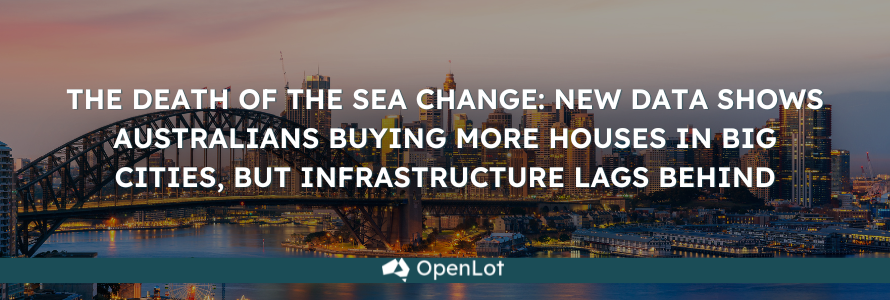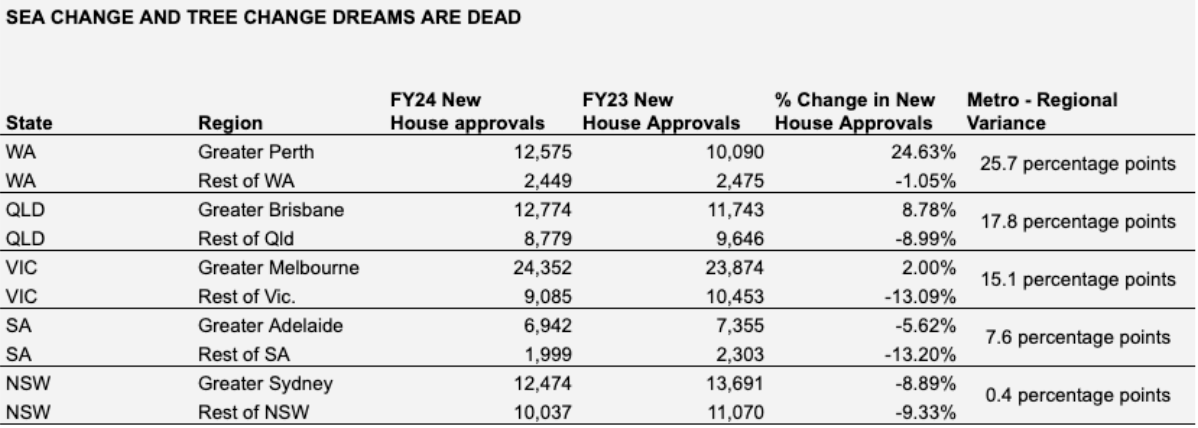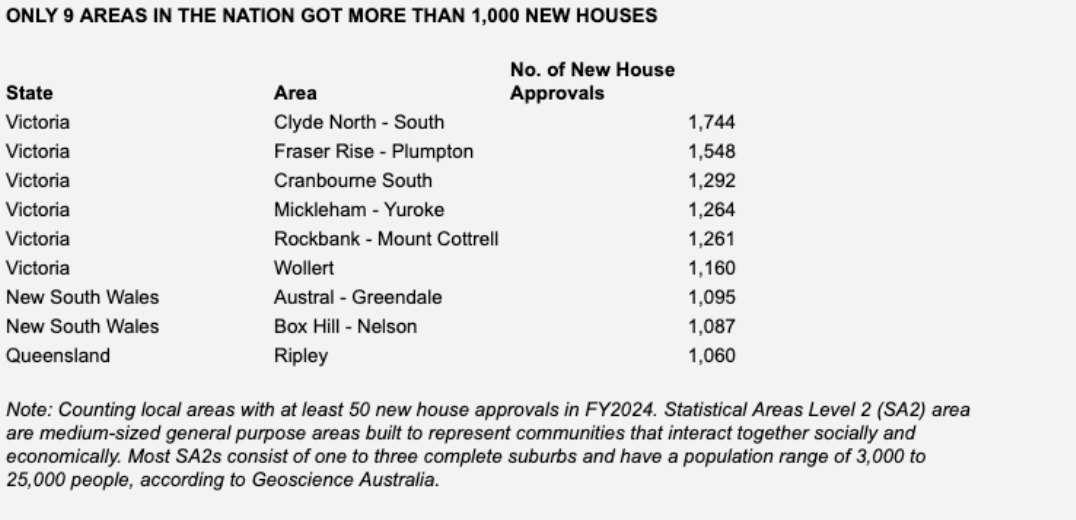
Melbourne (22 August 2024) — The Covid-era dream of living in a regional lifestyle destination and working remotely no longer appeals to as many Australians, according to new house approval data from Openlot.com.au and the Australian Bureau of Statistics. The data shows soaring new housing demand in the capital cities and plummeting demand in regional areas.
OpenLot.com.au is the consumer portal for new housing. New houses rather than apartments account for the majority of all new dwellings constructed in the country.
Preference for Big Cities Soared in FY24
Qi Chen, CEO and Cofounder of Openlot.com.au, said:
“Housing approvals growth was significantly faster in the capital city metro areas last year than in the regional areas. There’s a shift of gravity back to the big cities.The Covid-era dream living in a tree change or sea change town has lost its luster. People today want to live as close to the capital city as they can, while still having a house.
“Australia is a nation where people want to live in the big cities, and that preference became dramatically more pronounced in the 2023-24 year

"Perth is the most striking example because the number of new houses in greater Perth soared by 24.6% in FY24, while the number in Western Australian regional areas actually fell, by 1.1%.
“The big cities dominated regional areas in terms of new housing in the other states, too. In Brisbane, new house approvals climbed by 8.8% while they fell by 9% in regional Queensland.
“In greater Melbourne, new house approvals climbed by 2%, even as the number of new houses in Victorian regional areas fell by more than 13%.
“In Adelaide and Sydney, the number of approved new houses fell in both metro areas, but fell by less than in the regional areas. In Adelaide, new house approvals fell by 5.6%, much less than the 13.2% fall in regional South Australia.
“In Sydney, the difference in new house supply between regional areas and the capital city was the smallest, at only about half a percentage point.
NSW Regional Areas Where New House Approvals Fell Significantly
“Newcastle - Lake Macquarie and Coffs Harbour - Grafton are the only two regional areas that in New South Wales with double digit growth in the number of new houses approved in FY24. In Newcastle - Lake Macquarie, the number of houses approved jumped by 15.1% to 1,326.
“Coffs Harbour - Grafton was the best performing local area in the whole state, with 24.7% growth in new house approvals. In absolute numbers, however, Newcastle - Lake Macquarie saw more new houses approved: 174 versus 114 in Coffs Harbour - Grafton.
“The areas that had the biggest contractions in the number of houses approved in FY24 were Far West and Orana, Richmond and Tweed, and Southern Highlands and Shoalhaven.
“In places where you saw a contraction in the number of new houses approved, there's either a supply constraint, such as a limit to the available land, or affordability issues where construction and carrying costs have moved out of the reach of most buyers.
“Metro Sydney has a problem of land supply because its topography doesn’t allow a large number of new houses to be built. The market is going for more medium and high density development, so we expect to see new house sales slow in FY25.
VIC Regional Areas Where New House Approvals Fell Significantly
“The regional locations in Victoria that suffered the biggest drop in house approvals last year were Ballarat, Warrnambool - South West, and Mornington Peninsula.
“Ballarat fell further than any other Victorian regional area and saw house approvals slashed by 32.7% compared to FY23, but that is to be expected becauseBallarat had a boom year in 2023. The 1,600 FY2023 new house approvals in Ballarat were far from normal
“In Warrnambool - South West, house approvals plummeted by 24.5%
“House approvals in Mornington Peninsula cratered by 20.3%.
“The largest regional Victoria house market, Geelong, had a relatively mild result, with house approvals shrinking by just 7.6% there.
“In Victoria as a whole, the supply of new houses fell by 2.6% in the year. The number of new houses approved shrank in six out of 10 local areas. As in New South Wales, high interest rates have made affordability the biggest challenge to new house buyers.
“Our developer clients are holding back significant quantities of new inventory because buyers cannot afford what it costs to provide a new house. In some cases, new inventory is competing with house and land packages sold as little as two years ago that are now back on the market for less than the developers’ own listing prices.
QLD Regional Areas Where New House Approvals Fell Significantly
“The supply of new houses in Queensland changed little in the year, increasing just 0.8%. Queensland is a stable but hot market. The demand is there, and people can afford to buy it.
“Around the state, the number of local areas in which the supply of new housing decreased during the year outweighed areas where it increased. Just 44% of local areas saw an increase in the number of approved new houses, compared to the year before.
“From the buyer activity data on OpenLot.com.au platform, we see that Queensland remained a very strong market in FY24. Many developers are selling out as soon as they put out releases. The minimum change in housing approvals is driven by a combination of the static level of demand and by developers and councils’ controlled release of new supply. This situation represents a healthy Queensland house and land market. The demand is still there due to inter-state migration.
Queensland had the third-largest inter-state migration numbers in 2023, with 31,595 net interstate arrivals. That growth aligns with the new housing demand we saw there.
“The Queensland regional areas that suffered the biggest drops in house approvals were Toowoomba (-19.9%), the Sunshine Coast (-17.2%), and Darling Downs - Maranoa (-14.6%).
“Cairns and Townsville followed with drops of 10.6% and 9.9%, respectively.
“These locations were the only regional areas that performed worse than regional Queensland as a whole. Remember that these plummeting falls come in a state with steady new house approvals overall. The state showed a marginal increase of 0.8% for the year.
“The best performing regional areas was the Queensland Outback, with a 59.1% increase in house approvals, although this only amounted to 62 houses in total. Moreton Bay - North say a 22.1% increase, and house approvals in Ipswich jumped by 9.8%.
WA Regional Areas Where New House Approvals Fell Significantly
“Western Australia was the bright spot in Australia’s new house market in FY24 with new house approvals surging by 19.6%. It was the only state with a large increase in the supply of new houses, compared to the prior year. Most other states were flat or negative.
“Even though the supply of new houses in the state is leaping, the increase is unevenly distributed. More than half (57%) of local areas in WA saw an increase over the prior year’s number of new house approvals, while approvals decreased in 43% of areas.
“More interstate migrants moved to WA in 2023 than to any other state except Queensland: a net of 10,709 interstate migrants.
“In additional to being affordable, Western Australian houses also offered high rental yields¯ which attracted many investors, on top of the net interstate migration. Prices have already climbed and the rental yield is no longer as strong, so we predict that the boom won't continue in FY25.
“But booms have their costs, too. When sales happen so quickly, it can lead to problems later, such as labour shortages, construction cost inflation, and delayed delivery and settlement. what seems like a boom turns into a bust when housing growth is not matched by similar growth in construction trades and builders can no longer deliver at the contracted price. Instead, they go into bankruptcy.
“Huge booms like you saw in WA in 2023 are just not sustainable. We saw a similar boom-bust dynamic in Victoria during Covid, when the government there gave out the homebuilding grant.
“We don’t expect a further increase in house approvals this year. Our industry contacts tell us that those who invested a year ago have done very well, but prices have now climbed high enough that it’s no longer possible to make money like it was. Savvy investors are looking elsewhere to catch the next wave.
“The worst performing regional area in Western Australia is the WA Outback - North, with a 11.9% decline in house approvals, although that represents a fall of only 28 houses in absolute numbers, giving the relatively limited construction in the area.
“Bunbury is the regional area with the second-biggest fall, a decline of 4.5%. Other than Outback - North and Bunbury, no other area of WA outside of Greater Perth had house approvals fall during the year.
SA Regional Areas Where New House Approvals Fell Significantly
“In South Australia, new housing supply fell by 7.4% in the year, a significant drop that revealed the intense pressure brought to bear on buyers by high construction and mortgage costs. The decline in new housing was widespread, with fewer houses approved in 2023-24 than the prior year in 64% of the state’s local areas.
“In South Australia, the South East was the regional area with the smallest decrease in new house approvals: -4.9% compared to -7.4% for the state as a whole.
“Barossa - Yorke - Mid North had a comparatively massive decrease in house approvals with a 23% fall. The South Australia Outback was the worst performing regional area, with a 29.4% decrease.
“In Greater Adelaide, the North is the only area to with a fall of less than one percent. In Adelaide - South, new house approvals fell 3.2%. House approvals in Adelaide - Central and Hills dropped 12.5%. And in Adelaide - West approvals fell by 14.8%.

Infrastructure Lags Behind New Housing Development
“Nine local areas across Australia had more than 1,000 new homes approved in FY24. Six of those areas were in Victoria, two in New South Wales, and one in Queensland. But the infrastructure is not keeping up with the new housing.
“OpenLot.com.au’s Chen said, “The data shows that Victoria is Australia’s capital of land development. Greater Melbourne has the largest land pipeline. For buyers and investors, it’s a land of opportunity.
“In areas like this and Western Sydney, the infrastructure need to catch up. Roads need more lanes. Schools need to be built ASAP. Childcare needs to be constructed. And even buses are lagging behind and many areas don’t yet have a bus line.
“In New South Wales, you only have to look at Fifteenth Avenue in Austral to see an example of infrastructure that hasn’t kept up. A small country, two-lane road is the primary point of entry and exit for thousands of new residents in the suburb, and the state has yet to do anything about it. As a result, 40-minute delays to travel a few hundred meters are common.”
About OpenLot.com.au
OpenLot.com.au is the consumer portal for new housing, including land, house and land, and townhouses. Visit OpenLot.com.au for more information.





